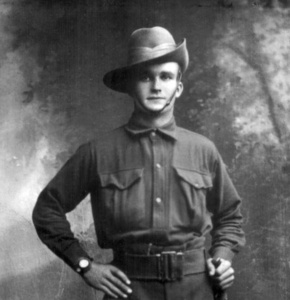SINCLAIR, Henry Lyall
| Service Number: | 102 |
|---|---|
| Enlisted: | 26 August 1914 |
| Last Rank: | Private |
| Last Unit: | 11th Infantry Battalion |
| Born: | Bowden on the Hill, South Australia, 13 June 1895 |
| Home Town: | Perth, Western Australia |
| Schooling: | Not yet discovered |
| Occupation: | Grocer, horse cart driver |
| Died: | Tuberculosis and Asthenia, Perth, Western Australia, 26 March 1930, aged 34 years |
| Cemetery: |
Karrakatta Cemetery & Crematorium, Western Australia |
| Memorials: |
World War 1 Service
| 26 Aug 1914: | Enlisted AIF WW1, Private, 102, 11th Infantry Battalion | |
|---|---|---|
| 2 Nov 1914: | Involvement Private, 102, 11th Infantry Battalion, --- :embarkation_roll: roll_number: '10' embarkation_place: Fremantle embarkation_ship: HMAT Ascanius embarkation_ship_number: A11 public_note: '' | |
| 2 Nov 1914: | Embarked Private, 102, 11th Infantry Battalion, HMAT Ascanius, Fremantle | |
| 25 Apr 1915: | Involvement Private, 102, 11th Infantry Battalion, ANZAC / Gallipoli, landed on North Beach at Gallipoli as part of the covering force | |
| 21 Jun 1915: | Wounded Private, 102, 11th Infantry Battalion, ANZAC / Gallipoli, Buried by an exploding shell, dug up suffering fractured skull and shrapnel fragments embedded in skull | |
| 7 Jul 1916: | Discharged AIF WW1, 102, 11th Infantry Battalion, medical discharge, permanently disabled |
Harry Sinclair's story
Harry (Henry Lyall) Sinclair, Service Number 102, was superbly fit and already in the militia when war broke out and was immediately accepted into the newly formed AIF in August 1914. His official enlistment papers stated conveniently that he was 21 years of age (even though he was only 19) which ensured he did not need to seek parental permission to enlist.
Harry left Fremantle with the 11th Battalion on 31st October 1914, headed for Egypt, Lemnos and Gallipoli. He survived the landing on 25th April, and later wrote to his sister describing the great battle that ensued over the next few days, ending with the words “They say we've made a name for our country, but we paid for it”.
On 21 June, a week after his 20th birthday, Harry was buried by an exploding Turkish shell. He was dug up unconscious but alive, his skull fractured and embedded with shrapnel fragments. After many months of hospitalisation on Lemnos, Malta and England, Harry was sent home to WA in 1916, arriving just in time for the first ANZAC Day commemoration.
When Harry was discharged permanently disabled from the AIF in July 1916, his war souvenirs included the half a dozen pieces of shrapnel the doctors had managed to extract from his skull. Harry’s English sweetheart, volunteer nurse Florrie Young, followed him to Australia some months later. They were married in Perth in February 1917. A bride at 21, by 34 Florrie was a widow with two children to feed.
Harry never recovered from his wounds, suffering constantly from horrendous headaches that were probably caused by the remaining pieces of shrapnel the doctors were unable to remove from his skull. He also had recurring chest problems which had started in Egypt and Lemnos prior to the Gallipoli landing.
Harry managed to work for a few years as a tram driver but eventually became too ill. Many long cold nights spent out in the open by the river, lying in wait with his rifle for ducks and other small game to feed his family, did not help his health. He died from tuberculosis in 1930, aged only 34, after spending the last few years of his life bedridden.
Harry never lost his fighting spirit, redirected after the war towards the Repatriation Department, as the correspondence in his Repatriation file testifies. He was a member of the RSL from its formation in 1916 until his death in 1930 and received much support from his local branch throughout his post-war tribulations.
Profile written by Wendy Lugg (grand-daughter)
Submitted 14 October 2018 by Wendy Lugg












